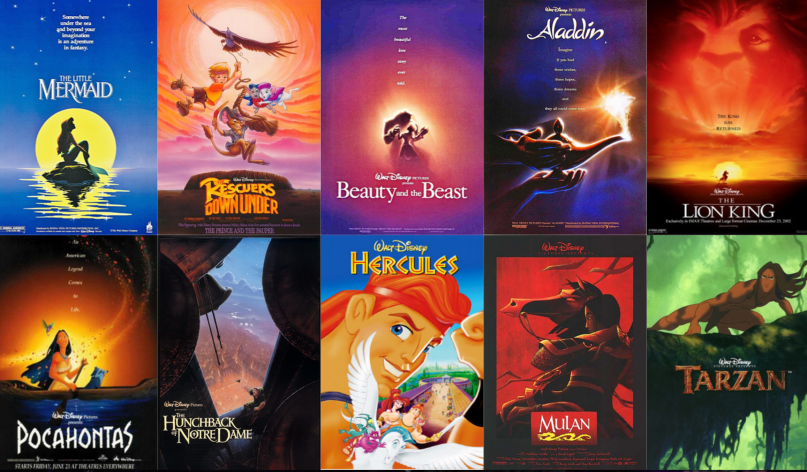The Disney Renaissance
April 6, 2017
The Disney Renaissance: How your favorite animation studio became a pop culture phenomenon.
Intro:
It may be hard to imagine but there was a point where the Disney Animation Studio was in a bit of a rut. They hadn’t had a true classic film come out since 1967’s The Jungle Book, and it looked as if the death of Walt Disney had created a halt in creative genius that Disney was known to have. But with the sudden release of ten movies over a ten year period, most of which are considered absolute classics, Disney had found the magic that it had been known to have once. With films that followed powerful female protagonists, retellings of popular stories, and even films that starred only animals, Disney was able to re-create the captivating experiences of which Walt Disney would have been proud. This period of time would later be known as “The Disney Renaissance,” a period of time in which Disney had re-found its creative genius and touched the hearts of all its viewers.
The Beginning and…
To really trace back the roots of this era we must go to 1988. With the release of the critically acclaimed Who Framed Roger Rabbit?, a movie that took place in real life and had animation as well, Disney felt it was the right time to go back to producing amazing animated films. To start off this era, they decided to go with a film that they ad been planning as far back as the 1930’s, The Little Mermaid. Disney had always planned to make the film a musical, like past films, but this time they wanted to make it more like a Broadway musical. With that in mind they hired lyricist Howard Ashman and composer Alan Menken, a move that greatly impact the scores of the movies to come. With the success of The Little Mermaid Disney looked like it was back on track, and it was. Disney never looked back releasing classics such as The Lion King, Aladdin, and Beauty and the Beast. Disney had found directors who created winning formulas such as Ron Clements, Jon Musker, and Kirk Wise to name a few who were able to create great pieces of animation. To this day, Disney has never stopped pumping out great animated films and does not look as though the end is anywhere near.
The Music:
Most times when you think of these classic animated movies the first thing that comes to mind is the music. Disney at this time was producing some of the best scores in music history. As mentioned before, they brought in lyricist Howard Ashman and composer Alan Menken who greatly affected the movies with their amazing music. Songs like “Circle of Life,” “A Whole New World,” “Part of Your World,” “Beauty and the Beast,” and “Colors of the Wind,” just to name a few, were all released at this time and to this day if you sing a couple of lines you could at least find a couple of people in the room to sing with you. The quality of the music has not gone unnoticed either. In this time from 1989 to 1999 the movies released won a whopping 11 Oscars just for their music. People went out of their way to listen to the music as well. Soundtrack sales were through the roof. Their lowest selling soundtrack hit Gold certification which is 500 thousand units sold. While their top seller The Lion King hit Diamond Certification selling over 10 million units. The music is what we remember most. Whether its singing the songs with friends or even at your wedding, Disney songs will stand the test of time, especially the songs released during The Disney Renaissance.
Box Office & Critical Acclaim:
Seeing Animated movies became a staple of the late 80’s to late 90’s. Millions would line up to wait and watch these movies and there is proof to back it up. In total, Disney had raked in 3.4 billion dollars off of the ten animated movies released. Their highest grossing movie turned out to be 1994’s The Lion King. Disney progressively got more and more people to see their movies as made evident through them breaking the box office record of highest grossing animated film of all time four times during the Renaissance. The record is currently held by another Disney film, Frozen. Along with amazing numbers at the box office, Disney was also getting love from critics and audiences alike. Disney made four movies that had a 90 percent or better score on Rotten Tomatoes and most others sat in the 80’s. Their lowest rated film was Pocahontas with a rating of 56 percent on Rotten Tomatoes, but audiences still loved it. The critical acclaim didn’t stop there. Beauty and the Beast, considered one of the best movies to come out at the time, was nominated for Best Motion Picture. This was the first time ever that an animated film was nominated for Best Picture. Animated films were no longer looked at the same way. They weren’t just for kids anymore according to Disney, they were films for all audiences.
Impact on other Animated Studios:
With the triumphs of the Disney Animated Studios and the resurgence of the animated movie, many studios wanted to replicate their success. Major film studios established new animation divisions such as Fox Animation Studios, Turner Feature Animation, and Warner Bros. Feature Animation and aimed to turn their animated films into Disney-styled musicals, however most attempts were met with largely mixed to negative reviews from critics and poor box office results. Fox Animation Studios had done so badly that they had to shut down their studio. Although some studios such as Dreamworks and Pixar found great success. The one method that Dreamworks used was having big-time stars voice their characters so they could bring in a bigger audience. Pixar on the other hand teamed up with Disney. Disney helped Pixar make Toy Story, an amazing animated feature from the 90’s that wouldn’t have been made without Disney. In return, Pixar provided Disney with technology that helped make most of their future movies. In a couple of years after a several more successful animated films, Disney pulled the trigger and bought Pixar which helped bolster their animated movies even more.
Impact on Animation Forever:
During this time, Disney was able to do things that no animation studio had ever done before. They told stories with daring female protagonists such as Mulan, Belle, and Ariel. They were also able to tell stories of very diverse cultures and people; from taking on Middle Eastern culture with Aladdin, to the country of China with Mulan, and even painting out the African safari with The Lion King. Disney made their movies more relatable to worldwide audiences, which in turn brought them more success. They were also the first animation studio to bring in big names to help some of their characters in their movies. Before, Disney would cast actors who were relatively known for their time on Broadway or in the theater world, but with the casting of Robin Williams as the Genie in Aladdin, superstars would come in and take these roles to make them their own. This would be a practice that other animation studios would replicate such as Pixar and Dreamworks to bring in a bigger audience and Box Office Revenue. Disney also introduced The Computer Animation Production System (CAPS) which played an integral par to their animation for years to come. The software allowed for a wider range of colors, as well as soft shading and colored line effects for the characters, techniques lost when the Disney studio abandoned hand inking for xerography in the late 1950s. CAPS also allowed the production crew to simulate multiplane effects: placing characters and/or backgrounds on separate layers and moving them toward/away from the camera on the Z-axis to give the illusion of depth, as well as altering the focus of each layer. This system was later ditched for 3D animated movies, but was influential in a ton of movies made during this time.
The Future:
At this time Disney is still running strong with their animated films. The magic is still there and more and more people are going to the theaters to watch the magic come to life. But one thing remains constant; all Disney fans will tell you that Disney had it’s best years in the Renaissance. Just think about it, why do you think Disney is making all these films from the late 80’s to late 90’s in live action? Not only do they want to recapture the magic that was there, but they also know how many people loved those movies. From their amazing music, leaps in technology regarding animation, and unforgettable characters and stories, Disney animators found the method that Walt perfected and influenced thousands of animators along the way.





